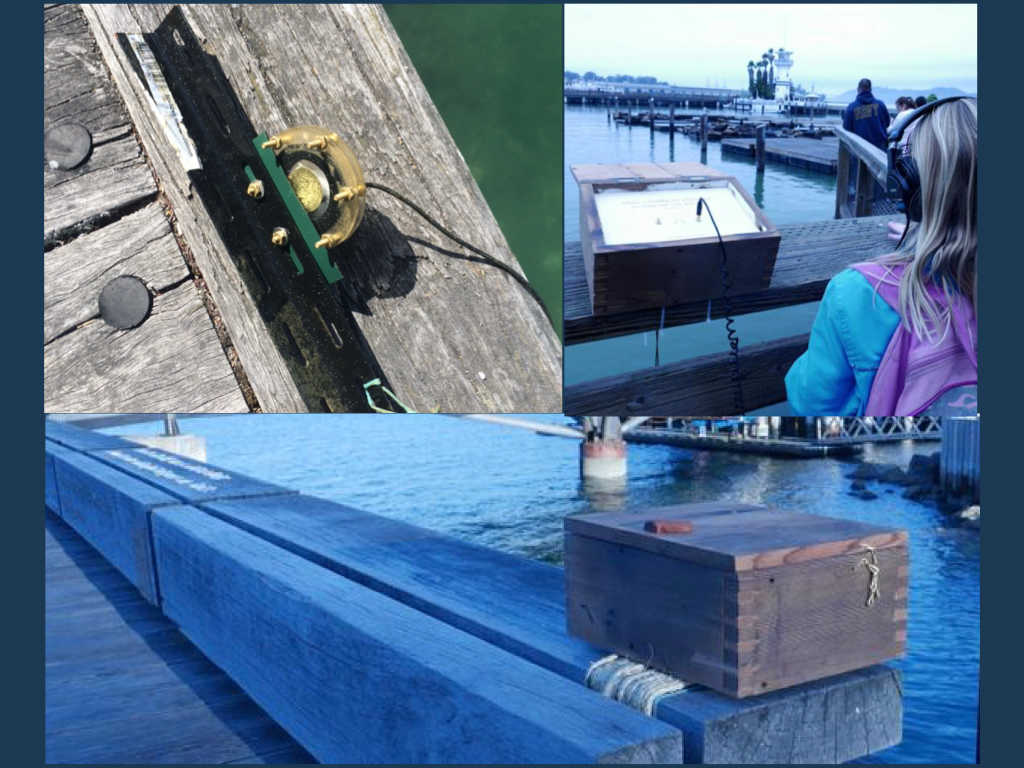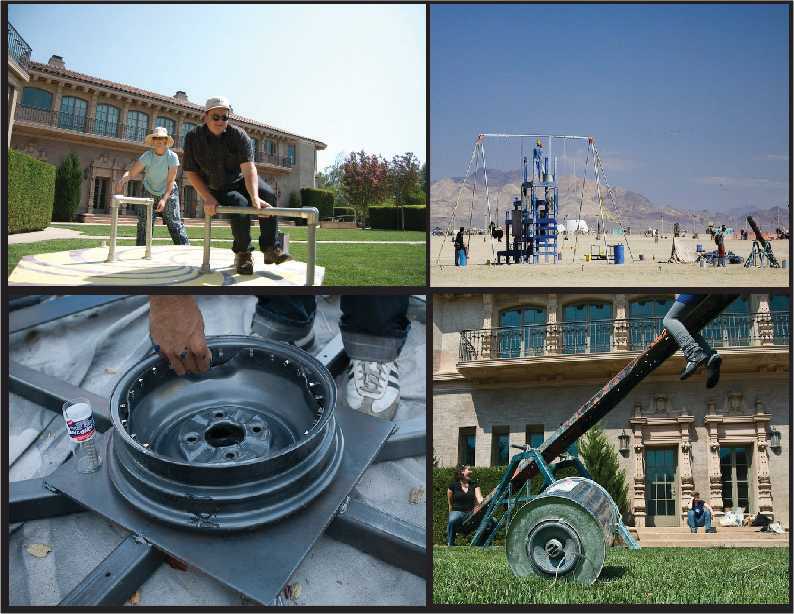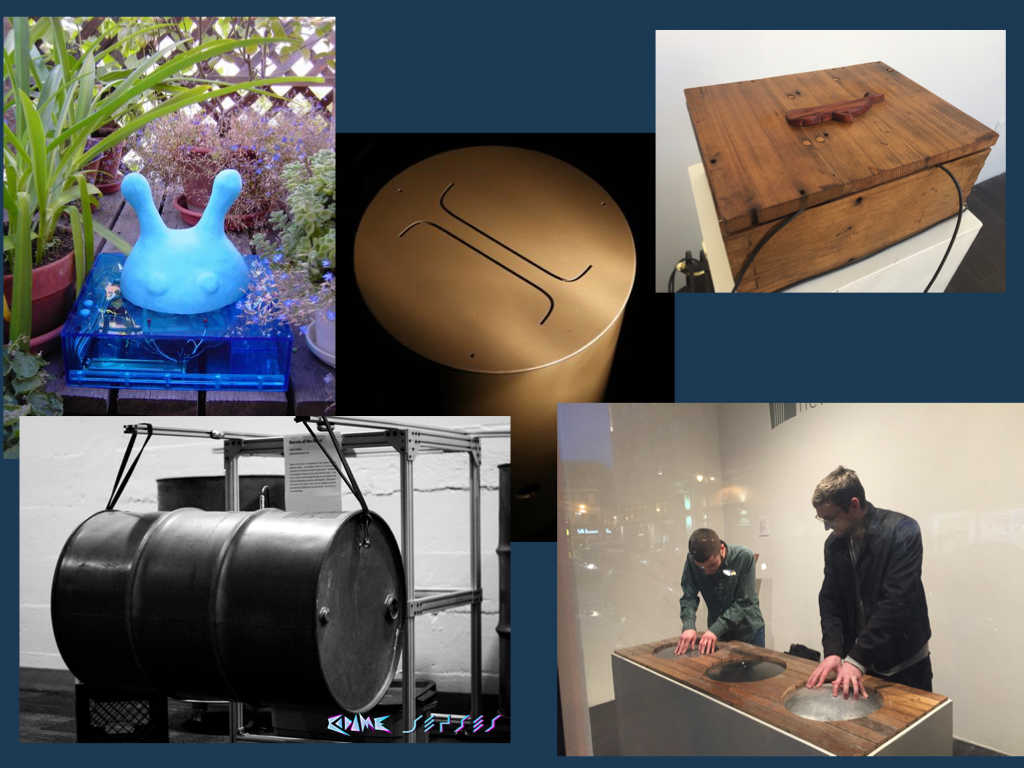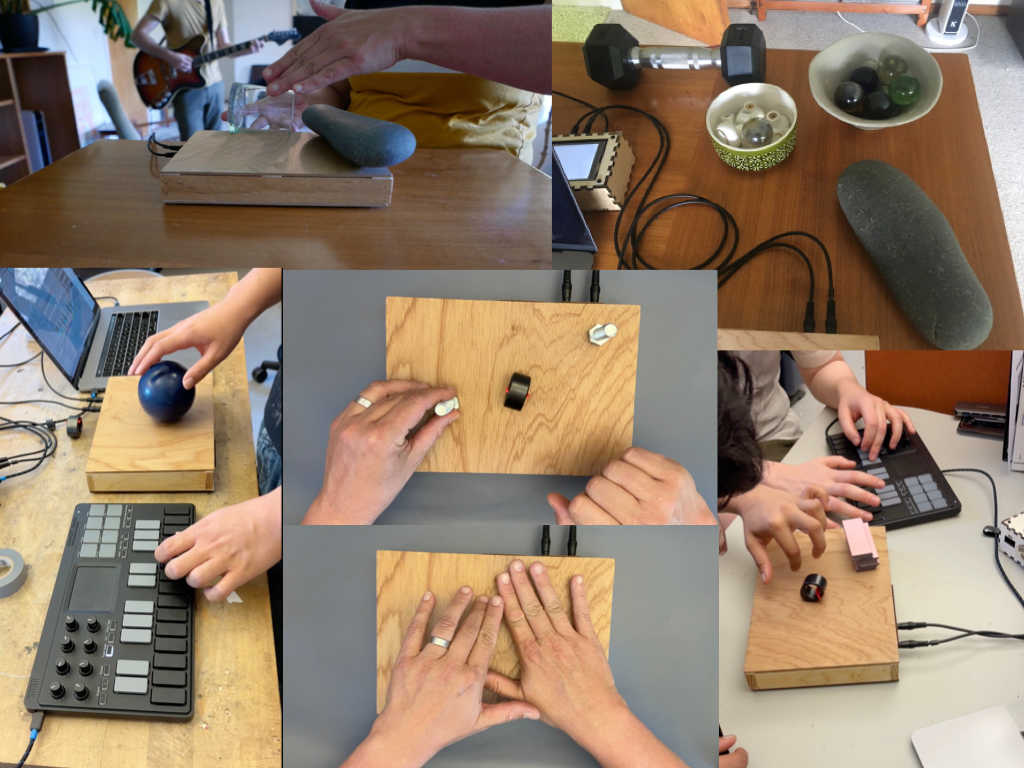Questions for
Sasha Leitman
Tell us about yourself right at this moment: geographically, musically, artistically, personally…
I am a sound artist from California and a permanent resident of Aotearoa New Zealand. My work usually focuses on the physical side of making music within a technologically augmented setting. I have just successfully defended my PhD thesis at Victoria University of Wellington on a new acoustic musical interface. I live with my family in the Wairarapa but we just came back from three months in California where I was teaching at Stanford University’s Center for Computer Research in Music and Acoustics (CCRMA). I am not sure what is next but the future feels pretty wide open for my family.
How did you come to art/making?
I started off composing and then got interested in sound design and electronics through working with whale sounds and underwater recording. I have always made and invented things and made music so making things that make music felt like a natural combination.

Pictured: Sonic Windows was first shown at the Wellington Fringe Festival. Each of three listening stations is made of wood from a sunken and demolished boat, made to look like a sailors’ ditty box. Listeners can use headphones to hear a live binaural underwater audio feed from homemade hydrophones.
Speaking of underwater, you've had a diverse career along the way in terms of jobs that weren't necessarily in the music field. Could you tell us a bit about each of those and how you feel they've contributed to where you are now?
I have had a lot of random jobs! In terms of underwater work, I have often worked as a diver cleaning boat hulls and doing minor repairs and finding people’s lost car keys. Diving in cold, turbulent water with 20 centimetres of visibility taught me lots of life lessons about staying calm and feeling connected to the environment, even if that connection was in the form of creepy crawly things brushing against my leg or brine shrimp getting stuck in my hair. I actually miss that kind of diving a lot and since this issue is about money, maybe I should go see if the Wellington cruise ships are still hiring bottom cleaners…
Over the years I have sold knives at fairs and festivals, been a waitress at Jocko’s steakhouse when I was a vegetarian, worked as an administrator, put on concerts and events, done maintenance and random handyman jobs, looked after elderly people, babysat, tutored, taught standardized test preparation, and a bunch of other jobs I can’t remember. I think this is common for people who are trying to make a life in the arts. It is hard to find a job that can accommodate our schedules and sometimes you have to try a bunch of things. For me, many of these jobs were also vehicles through which to learn practical skills about the world around me. This has come in very handy as my creative work has had a strong maker and hands on practitioner theme running through it.
Eventually, I worked for 12 years at CCRMA, eventually becoming a lecturer and research engineer where I could use all of those assorted skills for helping people bring their creative ideas to life.

Pictured: PlaySound Ground was an adult sized musical playground that was shown at several different venues, including Burning Man. It leveraged a wide range of DIY skills.
This BLOT issue is centred around themes of money and power, in an attempt to speak truth to it. Is there any commentary you'd like to give about your experiences and observations around these themes within the context of music/composition/funding/resources/gender/access? (This can of course be a positive take, your proposal for how things would work well!)
When it comes to money and the arts, I have only ever lived in California and Aotearoa. There are other countries that seem to do things differently, but I have only observed them from the outside so I am not going to discuss them.
I don’t think we will solve issues around money for artists until we solve the financial imbalances present in society as a whole. Money is hard for many people in both California and Aotearoa and so much of it revolves around high housing costs. This affects many fields—educators, health care workers, customer service, etc. Music and sound art are social art forms, so practitioners often need to live close to urban places so they can share their work and experience the work of others. If teachers in the public school system aren’t paid enough to afford rent (let alone a mortgage) for a family in Wellington or Auckland or Redwood City in California, it is hard to imagine a system where government funding would support the arts in a way that allowed people to afford housing in these places. It becomes a scramble for resources—gigs, teaching appointments, funding, grants, etc.—and that can lead to hoarding of resources. It becomes like a society-wide Pyramid scheme and it is getting harder and harder, especially for younger people.
On a more positive note, I think there are things that can be done about equity and access around resources. My personal tendency is to focus on the practical nuts and bolts of how access is restricted and how it can be at least partially counteracted. It is important that people in positions of power strive to communicate the unwritten rules, skills, and knowledge that are so often used as (often unintentional) gatekeeping. We can put structures in place that help to counterbalance our natural tendency to hire or recruit our friends, former students, and others within our typical social circle. In university settings, we can make sure that students who do not arrive with as much technical experience (or equipment) as other students have the support that they need to acquire those resources and skills. There are heaps of other things that can be done and many that are situationally or culturally specific. The main thing is to acknowledge that equitable access does not magically happen, we have to work on it intentionally, particularly if we are in even small positions of power.
Getting back to music/sound/performance, could you speak to the DIY nature of your work?
For me, music is a fundamentally physical activity and I love the materials that make up our physical world.
Much of my work engages technology in some way. Many applications of technology can sever our connection with the world around us but I am interested in the ways that combining our physical world with technology can actually help us re-embody our connection to the world. If Augmented Reality is about using computers to make our real world more interesting, I want to use our real world to make computers more interesting.
The DIY part is important to me because I want to know and understand the materials, processes and technology that I am using in my work. It is partially curiosity, but it is also a compulsion to break open black boxes and make sure that I am learning (and sharing) skills that are fundamental to the world around us. This can take the form of electronics or welding or coding or woodworking. I really want to know how the world around us functions and engage with it in a personal and creative way. This makes a DIY approach fundamental to the process of creation for me.

Pictured: My work has incorporated a wide range of materials and processes. Clockwise from top left: Sillytone Squish Factory, Sonic Wishing Well, Sonic Windows, Quiver, Barrels of the Beast.
Could you talk about the acoustic musical interface that you have developed as part of your PhD research?
The Resonant Object Interface (ROI) is an acoustic input system that uses the resonance of physical objects and our ability to dampen those resonances to control parameters in audio software. The ROI’s unique sensing methodology is built from resonant objects, vibration exciters and contact microphones. As users touch the resonant object, their hands dampen the signals from the vibration exciters. The goal is to provide nuanced, embodied, and expressive engagement with our digital tools.
Right now, I am focused on a cigar-box shaped form, but there are lots of other possibilities. Because it is an acoustic sensing system, it means that you can alter the acoustics of the interface through a wide variety of interactions—light touch, heavy touch, static objects placed on the box, moving objects traced over the box. It took a long time to tune the system so that people other than me could play it successfully, but now it is finally in that state it has been lots of fun to see people start to explore the device and find unexpected possibilities. One way to think of it is to say that if virtual reality seeks to use computers to make our real world more interesting, the ROI seeks to use the real world to make our computers more interesting.

Pictured: Resonant Object Interface, a Tactile Acoustic Input Device for Electronic Music.
Could you describe your creative process... how does your invention of objects and invention of sound works interact?
They work together. When I engage objects or materials or physical phenomena, I think about their sonic as much as their visual and interactive aesthetics. When I am thinking about sounds, I am thinking about how they can be physically created or modified. For me, music is a fundamentally physical and material experience.
What artist/practitioner/body of work captivates your interest at the moment, and how/why?
Right now, I am obsessively listening to Jon Batiste’s 2023 album World Music Radio. I missed it when it came out and is a wonderful and weird album, which I will probably listen to on repeat for the next two months.
For my own work, I am really delving into the concept of Tacit Engagement, which is an idea developed by Satinder P. Gill. It builds on Michael Polanyi's term Tacit Knowledge which is the idea that "we can know more than we can tell.” Gil frames the idea of tacit knowing within a larger context of how we define knowledge and intelligence. With the current AI boom, these questions become overwhelmingly important. There is so much knowledge that sentient beings hold (cultural, embodied, temporal, environmental, ecological, etc.), and unfortunately, there is a tendency to overly focus on mathematical types of knowing, such as logic and reason. Gil works with musicians, and I think music is one of the best lenses through which to look at how we interact and know our world because music is not just a cognitive skill that can be simplified into algorithmic rules. It is a place where all of those aspects of our experience listed above (cultural, embodied, temporal, environmental, ecological) combine to form a complex form of art and communication.
In interacting with the ROI, people have some experience with wooden boxes in their daily lives. They know what a cigar box feels like and can often imagine what it might sound like to tap one. Turning that into an input device requires a bridging of that tacit knowledge with new possibilities of timbral control. When I do a good job of building that bridge (through tutorials, presets, and examples), new users, regardless of their background, are often able to engage with the device in an expressive and nuanced manner within a couple of minutes. When I don’t form that bridge, the result is an extremely confusing situation for the user.
Could you speak to the influence of Dolly Parton on your life — work — practice?
I have been a Dolly Parton devotee since I was eighteen months old and still in diapers. I have always loved her music and her public persona, even when I got teased for it as a kid in Southern California in the 1980s. American Country and Folk music was my first musical language, and the storytelling and harmonies of that music is important in a lot of my work even when it might not be immediately obvious.
NPR did a great 9-part podcast called, “Dolly Parton’s America.” In the US, she is a unique cultural figure and is admired by people from different political and cultural positions. I do not know if Dolly Parton had any influence on my work or practice; she certainly had no influence on my fashion choices. But she is an incredible role model for how to live a life guided by joy, individuality, and kindness.
What gives you hope?
People creating work that they believe in.
References
Polanyi, M. (1966). The Tacit Dimension. Chicago: University of Chicago Press.
Gill, S. P. (2015). Tacit Engagement. Springer Cham. https://doi.org/10.1007/978-3-319-21620-1_1
Sasha Leitman is a sound artist, composer, inventor, and creative technologist from California, currently living in Aotearoa New Zealand. Her work is rooted in the belief that music is a fundamentally physical activity and often features elements of DIY craftsmanship, materiality, underwater sound, and embodied engagement with the world.
